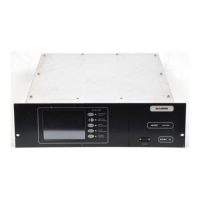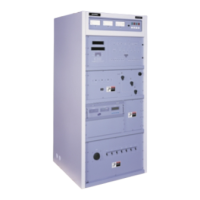c. Depress the HIGH power button. If HIGH power was
previouslysetfor25 kW,thetransmitteroutputshould now
be approximately 25 kW.
d. Depress the RAISE button until the power output reaches
30 kW or stops raising.
1. If the maximum power output is less than 30 kW, adjust
R27 for 30 kW output.
2. If the power output exceeds 30 kW, adjust R27 so that
the transmitter power will not exceed 30 kW.
5.6.2.3 Offset Adjustment: R84 (Modulated B-)
a. Connect a scope to the modulated B- output at A30 TP30
of the DC Regulator.
b. Operate the transmitter at5.0 kW and modulate 100% with
a 100 Hz sine wave.
c. Set up the scope at 1.0 Volt per division to measure a dc
coupled audio waveform. You should view a distorted sine
wave of approximately 2.0 Vp-p on a -3.0 VDC negative
offset. See Figure 5-7.
d. Adjust R84 so that the positive peak of this waveform just
begins to clip, then back off the control slightly. Note that
the waveform will reach the clip point as it moves more
positive. This positive peak of audio corresponds to the
modulation envelope negative peak.
5.6.2.4 Audio Gain Adjust: R15
The Audio Gain Adjust is normally factory preset for 100%
modulation with an audio input level of +10.0 dBm. It can be
adjusted for 100% modulation with audio input levels from -10.0
dBm to +10.0 dBm. To adjust:
a. Operate the transmitter at the desired output power and
slowly increase the output of the audio generator to the
desired level.
b. Adjust R15 for 100% modulation.
c. The RF output may vary when adjusting this control. Once
R15 is adjusted, thepoweroutput mayneed to beresetwith
the RAISE and LOWER buttons.
5.6.2.5 Dither Level Adjust: R43
The Dither control is preset and there should be no need for
readjustment. If it is desired to check the setting of the control,
use the following procedure.
a. Operate the transmitter at approximately 1.0 kW output
and modulate with a 100 Hz tone at 95%.
b. Use a scope to display one cycle of demodulated audio
from the modulation monitor.
c. Expand the vertical sensitivity of the scope to display only
a portion of the waveform.
d. Adjust R43 maximum counterclockwise. At this point it
should be possible to see some of the individual Digital
Modulation voltage steps. (It may be possible to see the
steps better at a lower modulation level, but it may also be
necessary to externally sync the scope with the audio
generator).
e. While observing the individual steps, adjust R43 clock-
wise until the individual steps can no longer be distin-
guished. This should occur within two turns of R43. Ad-
ditional clockwise adjustment of the control may appear
to further smooth out the steps but will result in additional
noise on the waveform.
f. Only increase the Dither Level enough to just smooth out
small step transitions. Other, slightly larger, steps or
glitches will be seen at low power and modulation levels.
This is normal. Do not use R43 to try and smooth these
out. Never use more than three clockwise turns of R43.
5.6.3
Oscillator (A17)
Preset the replacement board before installation by placing all
jumpers in the same positions as in the board to be replaced.
These are identified in Table 5-2.
a. Set S1, a four section DIP switch, to the same setting as
the board to be replaced.
b. Adjust the tuning slug of L4 with a non-inductive tuning
toolfor approximately the sameamount of penetrationinto
the coil.
c. RemovetheheaterassembliesfromcrystalsY1andY2.An
angle bracket bolts to the PC board and holds the crystal
heaters in place.
d. Carefullyremovethecrystalsand reinstall themonthenew
board. Install the heater assemblies on each crystal.
5.6.3.1 Carrier Frequency Adjust: C1/C3
a. Select crystal oscillator and heater Y1 by moving jumpers
J1andJ6toposition1-2.
b. Turn the low voltage on for 15 to 20 minutes.
c. Connect a frequency counter to BNC connector J5 and
adjust C1 with a non-inductive tuning tool for the correct
carrier frequency.
JUMPER FUNCTION
P1 CRYSTAL SELECT
P2 CRYSTAL FREQUENCY DIVIDER SELECT
P3 INTERNAL/EXTERNAL OSCILLATOR SELECT
P4 SINGLE/COMBINED TRANSMITTER SELECT
P5 EXTERNAL INPUT TERMINATION SELECT
P6 CRYSTAL HEATER SELECT
Table 5-2. Oscillator A17 Preset Jumpers
Section V - Maintenance
Rev. Z1: 06-02-00 Additional info to ECN 46105 888-2297-002 5-7
WARNING: Disconnect primary power prior to servicing.
